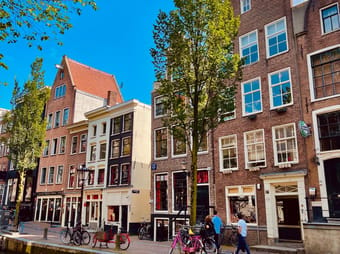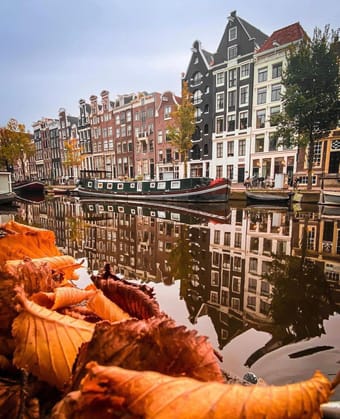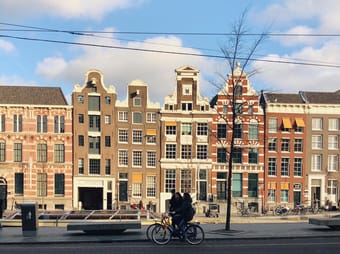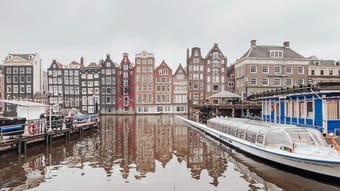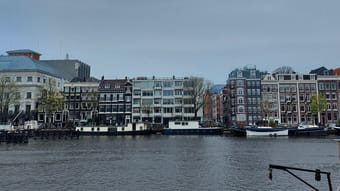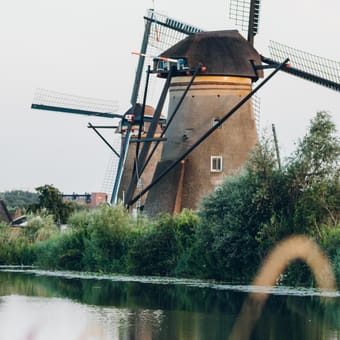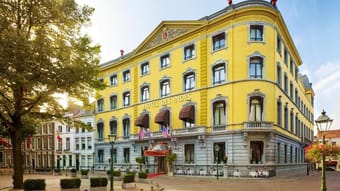Results for Amsterdam, The Netherlands
Beer lovers — this one’s for you. Want to try delicious Dutch brews and get to know this one of a kind city in the process?
Amsterdam is a special place: a bucket-list destination renowned for its charming canalside homes, endless entertainment, and plethora of world-class museums. The city is also home to some seriously badass breweries and beer halls. Oft overshadowed by its historically famed neighbors, Belgium and Germany, beer in the Netherlands deserves more attention.
In this guide, you’ll find a full list and insider tips re: Amsterdam’s must-visit breweries, as well as some can’t-miss beer-centric bars. It’s more than enough drinking to keep you going (or knock you out) for more than one trip.
For food & activites to go with your beer, check out my FREE FORA GUIDE: https://www.foratravel.com/guides/3VAB5E/beer-tour-amsterdam-maggie-danielli-pecorino — lots of gems hidden here.
PROST!
$5.00
0
🌎Explore The Netherlands!
⭐️Learn everything from getting around, where to stay, what to do, and where to eat!
✏️This guided map includes descriptions, opinions, tips, and more!
💵All my guided maps cost $5 for every 100 places. I am always adding more, so get it before the price goes up! That compensates the time it took me to research and build the perfect guide.
Free
1
This guide takes you on a sassy tour of the city of the canals or the “Venice of the North” - with a bit of something for everyone!
The city is famous for its arhitecture, art museums and traditions that are well kept alive and praised. But it is also famous for cannabis-serving coffeeshops (this guide provides a list with such venues), red-light district, quirky bars and bizarre museums.
So, whether on foot or by bike/boat, take this guide & stroll around this outstanding city in search for fun, food, souvenirs and all those Dutch vibes that you heard so much about.
When it comes to traditional food, be sure to try:
- Haring or 'Hollandse Nieuwe' (Dutch new herring), probably the most famous Dutch food. Pickled herring is a delicacy in Holland. The raw herring is served together with chopped raw onions and gherkins.
- Stamppot, an old dish of mashed potatoes combined with root vegetables, like turnip, carrot and onion, but it can also include dark, leafy greens like kale/spinach (make sure you order it the traditional way, with smoked sausage).
- Erwtensoep, a thick split pea soup;
- Bitterballen similar to a scotch egg, they are balls of finely chopped beef or veal that are seasoned with a mixture of spices, then rolled in bread crumbs and deep fried.
Also, make sure you try out some desserts:
- Poffertjes, small pancakes, baked in an iron skillet and traditionally served with melted butter, dusted with icing sugar
- Pannenkoeken, another traditional sort of pancakes
- Oliebollen ‘oil spheres' are balls of dumpling batter fried in hot oil and later sprinkled with icing sugar.
Highlights:
🌷Dutch tulips - It was in the 16th century that tulips were imported to Holland from the Ottoman Empire. In no time, tulips became the most sought-after commodity in the entire Netherlands, after Carolus Clusius wrote what's considered the first major book about the flower. In the early 1600s, professional cultivators of tulips began to refine techniques to grow and produce the flowers locally in Holland, establishing a flourishing business sector that has persisted to this day.
The tulips mostly bloom during the spring season, from mid-April to mid-May, in Amsterdam. The Tulip Festival will begin on March 23rd and go on till May 14th, 2023
👡 Klompen - Dutch clogs are a type of footwear made in part or completely from wood. The iconic footwear of the Netherlands were the shoes of choice for Dutch laborers of centuries past. The wooden slip-ons were sturdy, cheap and—when stuffed with straw—cozy and warm. The first Dutch clog is dated from the year 1230. The shoe is deeply ingrained in Dutch culture and some people in rural areas still wear them today!
🚲 Dutch bikes - are a style of urban commuting bikes that have been used in the Netherlands for decades and have grown in popularity in cities around the world. Dutch bicycles are upright or “sit-up” style – with taller frames than typical bicycles. This position allows for very good visibility and great comfort. A popular form of Dutch bicycles is the Omafiets (translates to Grandma's bike).
🗼 Dutch windmills - were built originally to pump the water out from the land because the Netherlands is so flat and below sea level. With the land always getting flooded, farming was almost impossible, hence the need to force out the water by means of the windmills.
🧇 Stroopwafel - the most classic of all Dutch sweets and a perfect gift from Holland - literally means “syrup waffle” and it’s a round crunchy waffle with chewy caramel filling. The correct way of eating it is: put it on your coffee or tea cup and wait for a minute until the caramel melts and the waffle warms up – it enhances its flavour and makes it taste as fresh from the oven. Delicious!
🧀 Dutch cheese - especially Gouda, Edam and Maasdam, well known and exported all over the world. Apart from the classics, try some really special ones: a turquoise-coloured cheese with lavender, pink-coloured cheese with red pesto, champagne gouda or even… coconut gouda! A typical cheese from Amsterdam is Old Amsterdam, exceptional premium aged gouda cheese.
🥃 Genever (also called Jenever) - is the traditional liquor of the Netherlands, from which gin has evolved. Some tasters say the flavor of this spirit is similar to white whiskey. Oude (old) genever is the traditional style, with a malty botanical flavor. Jonge (young) genever is a newer recipe with a cleaner taste, more similar to vodka.
There are several genever distilleries in Amsterdam, each with their own secret recipes.
Solo Female • Groups • Adventure • Architecture • Art • Foodie • History • Shopping
$5.00
23
Amsterdam is the first stop for many incoming (and departing) international flights so you may find yourself with a long layover and want to get out of the airport and explore.
In this guide we’ll share everything you need to know about a layover in Amsterdam.
How do I get from the airport to the city center?
The train is a quick and convenient way to arrive in the city center in less than 20 minutes. You can even use your contactless debit card, credit card or mobile phone to pay and not worry about messing around with the ticket machines. Just tap and go. Each way costs about 5 euros per person making it relatively affordable too considering how much it can cost to get to and from the airport in other major European cities like London and Paris.
Where do I store my luggage?
If you have bags or suitcases you’d like to store while you’re out exploring you can use luggage lockers or the baggage storage area. There are 5 luggage lockers after security that cost 8 euros a day. The lockers are 40x40 cm and have a depth of 70 cm.
You can leave bags in a locker close to your departure gate before leaving the secure area or take them to baggage storage on level -1, between Arrivals 1 and Arrivals 2. Hand baggage (max size 55x35x25cm) costs 6 euros a piece per day. You can also store larger luggage here for an additional fee. You can view the map on the Schipol website and search “locker” to find the luggage lockers after security or search “storage” to see where the baggage storage before security is located. Additional information on luggage storage can be found on the Schipol Airport website.
What can I do on my long layover?
There’s a lot you can do near Amsterdam Centraal.
- Take photos at the row houses.
- Take a boat tour for a unique perspective of Amsterdam from it’s iconic canals. The Our Lord in the Attic Museum is a lesser known spot just around the corner from where many of the boat tours leave.
- Visit Amsterdam’s oldest building, Oude Kerk Amsterdam, which was a church but is now used for concerts and cultural events. It’s located in the middle of the Red Light District.
- If you’re looking for free sites, check out the Basilica of Saint Nicholas. It’s free to visit and just only a 5 minute walk from Amsterdam Centraal.
- Do some shopping on Damrak Avenue and grab souvenirs like cheese (many of the stores offer free samples!) and other Dutch goods. HEMA is a cute store worth checking out for affordable and often practical souvenirs as well.
- At Dam Square you’ll find the ornate Royal Palace Amsterdam and The New Church.
- One of the best ways to enjoy Amsterdam is admiring the picture perfect canals. If you want to go inside a canal house and see what it was like back in 1620, check out the Museum House Bartolotti.
- If you want to visit the Anne Frank House be sure to reserve your tickets two months in advance!
How long do I need for a long layover?
We wouldn’t recommend leaving the airport if you have less than a 6 hour layover. If you’ve been to Amsterdam before and are familiar with the airport, public transportation, and the city you can maybe get away with leaving on a shorter layover, but for first time visitors you want to make sure you give yourself enough time.
Seven hours or more would be ideal. Remember, if you’re traveling internationally and this is your first stop in Europe, you’ll need to go through customs and immigration and if it’s your last stop before leaving Europe you’ll need to go through immigration after security when leaving. The lines for immigration can be quite long in Europe so always give yourself plenty of time and stay up to date on current conditions at security.
What can I do if my layover is under 6 hours?
If you have a short layover there are a lot of shopping options in the Schipol airport. Pre-security you can find local stores like the grocery store Albert Heijn or the department store HEMA for local souvenirs or shops like Bloem and Fleurtiek for tulips and bulbs.
Also, before security check out the Panorama Terrace for plane spotting and tour a KLM Fokker 100 plane too!
Just because you can’t make it into the city doesn’t mean you can’t enjoy the artwork from the Dutch masters. After security the Rijksmuseum Schiphol has a small collection of art from the middle ages to now straight from the Rijksmuseum. It even has its own gift shop.
You can also visit the Airport Library with books by Dutch authors in different languages, music, and other cultural displays.
Do I need a visa to leave the airport on my layover?
That depends on what country your passport is from. As of now US citizens do not need a visa to visit the Netherlands. Starting in 2025 US citizens (and other countries) will need an 8 euro ETIAS travel authorization. That official date for when that will be rolled out has not been announced, but you can check this site for updates.
Free
0
Welcome to my ultimate FREE travel guides to the Netherlands, a land of picturesque landscapes, rich history, and vibrant cities!
Unveil the charm of this diverse country with our curated hotel and restaurant recommendations, promising a delightful stay and delectable dining experiences. From wandering through iconic windmills to cruising the enchanting canals of Amsterdam, this guide will lead you to the coolest things to do in the Netherlands. Embrace the Dutch culture, explore hidden gems, and create unforgettable memories on your journey through this captivating destination!
Coming up:
- Beste Beaches
Adventure • Boutique • Budget • Luxury • Foodie • Shopping • Romantic • Road Trip • Photography • Slow Travel • Sustainable/Eco • Nature • Wine • Coffee • Beach
Free
0
Welcome to The Hague, the vibrant city in the Netherlands where history and modernity intertwine seamlessly. As the seat of the Dutch government and the International Court of Justice, The Hague boasts a stately atmosphere adorned with grand palaces, elegant squares, and beautiful parks. Discover the city's rich cultural heritage through its world-class museums, stunning art galleries, and iconic landmarks. Immerse yourself in the local way of life by exploring charming neighborhoods, savoring delicious Dutch cuisine, and experiencing the lively events and festivals that grace the streets year-round. Whether you're fascinated by history, captivated by art, or simply seeking a delightful escape, The Hague promises an unforgettable travel experience.
Besides Amsterdam, I've lived in the Hague for a while. So this list is based on my own experience, so first hand advice.
Enjoy your time in the Hague.
Boutique • Art • History • Shopping • Design • Luxury • Budget • Romantic • Sustainable/Eco • People & Culture
Free
0
Backpack Aleks
Available for hire
Europe in 3 weeks 🇩🇪🇮🇹🇫🇷🇲🇨🇧🇪🇳🇱 24 days budget itinerary through 6 European countries
This itinerary will take you through 6 European countries in 24 days. It starts and ends in Frankfurt as it has one of the major airports in Europe. I will walk you through day-to-day, places to visit, activities to do and what are the best options when it comes to transport between locations. I created this itinerary after travelling through Europe for the last few years. I combined my experiences to create a compact itinerary that lets you make the most out of 3 weeks in Europe.
📍Germany
📍Italy
📍Vatican
📍France
📍Monaco
📍Belgium
📍Netherlands
What is included:
✔️ Day to day itinerary for 24 days
✔️ Recommendations for activities in each location
✔️Two recommendations for budget accommodation in each location
✔️Food tour recommendation for each country to taste traditional food
✔️Comparison (price, duration, convenience) of transport options - bus, trains and Eurorail pass.
What is not included
❌Restaurant recommendations
50+ • Accessibility • Backpacker • Car-free • Couples • Digital Nomads • Family • Groups • Gluten-free / Celiac • Halal • LGBTQ+ • Pets • Plus Size • Female Solo • Vegan • Vegetarian • Adventure • Architecture • Art • Boutique • Budget • Design • Faith • Foodie • History • Outdoors • People & Culture • Photography • Relaxation • Road Trip • Romantic • Shopping • Sustainable/Eco • Wellness • Wine
$15.00
3
What to do on one of my favorite islands in The Netherlands. It's a 75-minute train ride from Amsterdam Central with an amazing history and good places to do both surfing and other water activities. This travel guide is a pick-and-choose where you can decide which day to do! Since it is a small island there isn’t a set way to explore
Most of the information on the island like menus or museums is in Dutch, English and German
Free
0
Welcome to the board showcasing cities and places from 15 different countries across Europe. This board provides a glimpse into the variety of cities and landmarks of each featured country.
What You’ll Find:
Cities: Major urban centers and capitals.
Landmarks: Monumental places and lakes.
Featured Countries:
Austria
Serbia
Greece
Netherlands
Italy
Hungary
Germany
Poland
Switzerland
Montenegro
Croatia
Slovakia
Czech
Slovenia
North Macedonia
How to Use the Board:
Explore: Check out information on each city and place.
Compare: See how different cities and places contrast in terms of size, culture, and significance.
Plan: Use the board as inspiration for your travels or projects.
Dive in and discover the charm of European cities and places! We hope you find our board useful and inspiring.
Free
8
Destination ideas for your first solo travel adventure in Europe, inspired by my experiences solo-travelling 20+ European nations.
Discover:
✈️ 40+ destinations
📝 to-knows for every country
💰 budget considerations
💯 solo-travel advice
🗺 interactive embedded map
For recommendations tailored to your solo-travel adventure, hire me on Thatch!
Save this guide for later!
Backpacker • Female Solo • Digital Nomads • Car-free
Free
17
Ask ThatchGPT
